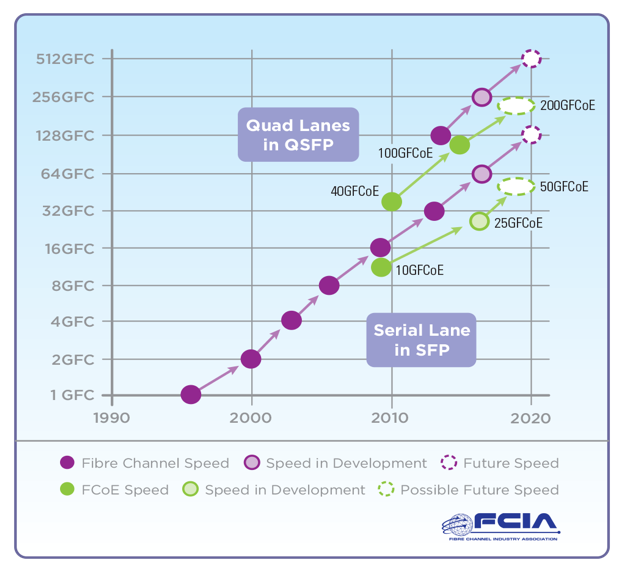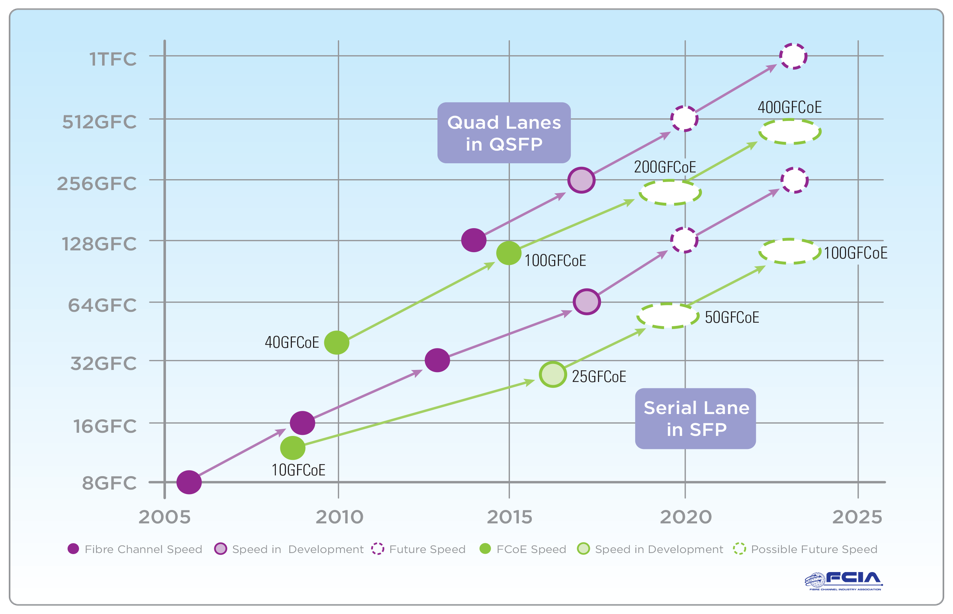Scott Kipp, Brocade
The heart and soul of any technology, and the industry association that stewards the technology, is its technology roadmap. Just like the term suggests, a roadmap shows not just the history of a technology, but also is a guide to where it is going and when it is going to get there.
The Fibre Channel Industry Association’s roadmap has helped the industry see the future of Fibre Channel for over 15 years. Fibre Channel has always had a clear vision of the road ahead, where the link speeds double every 3-4 years when the speeds can be cost-effectively doubled. Figure 1 shows the history of Fibre Channel speeds and the future speeds through 2020.
 Figure 1: Fibre Channel Speeds
Figure 1: Fibre Channel Speeds
Figure 1 shows how Fibre Channel has traditionally used only serial speeds for the first several generations. These serial speeds have used the venerable Small Form Factor Pluggable (SFP) module. The current generation of Fibre Channel, known as Gen6 Fibre Channel, uses the SFP28 (an SFP that runs at 28Gb/s) for 32GFC as well as the Quad Small Form factor Pluggable (QSFP28) module for 128GFC. The T11 INCITS technical committee is currently defining future generations of Fibre Channel speeds that will continue this tradition with 64GFC in an SFP and 256GFC in a QSFP.
Of course, Fibre Channel is more than just the physical link between devices, it is also the protocol by which storage traffic is transported across the Data Center. As a result, the Fibre Channel industry has long-embraced servers connecting to Fibre Channel storage via Ethernet with Fibre Channel over Ethernet (FCoE). FCoE uses the Ethernet physical layer and runs Fibre Channel frames and protocol over that physical layer of Ethernet.
These physical layers of Fibre Channel and Ethernet are marching at a similar pace now. While Fibre Channel has continuously doubled speeds from generation to generation, Ethernet used to grow by a factor or 10 until 40GbE came along. 40GbE, which is based on 4 lanes of 10G technology, broke the 10X paradigm and opened the door to more moderate steps in speed. Similar to technology progressions like Moore’s law and storage capacity, doubling of lane rates is the new norm. Individual lanes can then be grouped together to form new speeds. While Ethernet continues to use up to 16 lanes for router applications, only 1X and 4X lanes are shown in the 2015 Fibre Channel Roadmap because these are the only relevant speeds for SANs.
While Fibre Channel standards are completed in advance of products being released by at least a year, some Ethernet products are released before the Ethernet standard is ratified. This odd comparison of standards and products means that Ethernet products of similar speeds are released at about the same time as similar Fibre Channel products. For example, 25GbE/100GbE products running at 25.78125 Gb/s and 32GFC/128GFC products running at 28.1Gb/s began to be widely available in 2016 for the first time. High speed Ethernet and Fibre Channel products are basically running on similar physical layers.
The Fibre Channel roadmap doesn’t stop there. In Figure 2, the roadmap extends to Terabit Fibre Channel – that’s almost 1,000 Gigabits of data per second. Following the 1X/4X paradigm, Fibre Channel and Ethernet plan to double individual lane speeds repeatedly over the next decade. With Fibre Channel’s focus on storage in the data center, Fibre Channel will continue to standardize speeds before Ethernet.
While Fibre Channel will double speeds from 28Gb/s to 56Gb/s in 2017, Ethernet plans to double 25Gb/s to 50Gb/s between 2018 and 2020. The trend will continue with Fibre Channel lanes doubling to 112Gb/s and then 224Gb/s. When 4 lanes of these speeds are aggregated, the combined speeds will deliver almost a terabit/second of data for what will be known as Terabit Fibre Channel (1TFC).
The Making of a Roadmap
An accurate roadmap provides a reliable guide for suppliers, manufactures and distributors of products to plan their product development and release cycles based upon the features and timing of the technology migration reflected in the roadmap, based on open standards that are technically stable and complete. Some technology developments outlined in reliable roadmaps are required building blocks for product development. For example, lasers in optical modules need to be developed before the transceiver modules can be developed that will eventually be used in a switch or host bus adapter.
FCIA’s Roadmap Committee produces the FCIA Speedmap in concert with the ANSI INCITS T11.2 Task Group, the standards body that defines Fibre Channel speeds. Since FCIA meets at the T11 meetings, and its roadmap committee includes many of the key T11.2 standards engineers as well as key Fibre Channel supplier technical engineering and marketing experts, the resulting roadmap is the refined product of an intense iterative process that pinpoints highly attractive market propositions balanced with sound engineering feasibility.
Other important elements defined in the MRD include backward compatibility. For instance, just like 1GFC, 2GFC, 4GFC, and 8GFC edge connectivity, 16GFC and 32GFC are required to be backward compatible at least two generation. These speeds are auto-negotiated with no user intervention required, – i.e., 16GFC will automatically run at 4GFC and 8GFC, whilst 32GFC will automatically run at 8GFC and 16GFC. 128GFC continues Fibre Channel’s long history of ensuring total backward compatibility by also operating at four separate lanes of standard 16GFC or 32GFC or any combination of the two. This important level of backward compatibility has been and will continue to be a major benefit in Fibre Channel’s continued success.
The end result is an official FCIA Speedmap and Marketing Requirement Documents (MRDs) that become T11.2’s map of speeds and timelines. The MRDs define sets of features and benefits that are not only feasibly doable within the Speedmap timelines, but also results in actual products delivered in the prescribed timeframe that realize massive market success.
The Fibre Channel Roadmap has been printed as a physical, folding roadmap and an electronic version can be downloaded at: https://fibrechannel.org/roadmap.html.
Figure 2: Future Speeds for Fibre Channel and Ethernet









